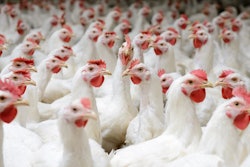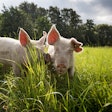
High-oil soybean varieties could bring some challenges to the animal feed industry
During the most recent Poultry Tech Summit, organized by WATT Global Media in November, a very serious concerned was voiced. It reflected the uneasiness of the animal feed industry regarding the future of soybean meal quality in the U.S., especially where it affects the U.S. poultry and swine industries.
As it is widely known, the U.S. government has indicated its preference for green fuels to enhance energy self-sufficiency and protect the environment. This is indeed great news for soybean farmers. It is expected that farmers will now be producing even more soybeans throughout the U.S. to be crushed for oil destined for the production of biodiesel. At the moment, a bonanza of soybeans and, consequently, soybean meal is expected in the near future for the U.S., and this might indicate a lower price for soybean meal, and/or greater exports of this valuable co-product. Again, this is great news for the animal feed industry as this indicates better (lower) prices for U.S. soybean meal.
The concern expressed at Poultry Tech Summit had to do with the possible spread of high-oil (not just high-oleic) soybean varieties in the future. These are soybeans that would contain more oil than normal seeds today, and possibly less protein and more fiber components. If such soybean varieties prevail over current ones, then the resulting soybean meal may be lower in crude protein and even lower in protein quality, and consequently higher in fiber and perhaps several of the soy anti-nutritional factors. Although fiber per se no longer bears a negative connotation in the animal feed industry, there is always a qualification and quantification aspect for this nutrient.
Short-term forecast
Right now, high-oleic soybeans are grown mainly around two areas, one in the Midwest and another along the East Coast, and there is no immediate plan to switch to normal high-oil soybeans. These high-oleic soybeans are destined mostly to human nutrition value chains. As soybean farmers, grain elevators and oil crushers all depend on large and uniform harvests of soybeans, it is not possible to handle separate varieties with ease, and any such switch cannot happen overnight.
Even seed companies will need time to produce enough seeds for everyone in a hypothetical scenario where everyone would want to grow high-oil soybeans. Nevertheless, given the right financial incentives, it is very likely that soybean farmers will make efforts to maximize their income through genetics that produce more oil per acre at the same or less cost (market-driven economy principles). It is also very likely that neither farmers nor crushers will increase their focus on future soybean meal protein and fiber components, especially when there is a strong export demand.
Midterm forecast
It would be rather idealistic to expect a greater collaboration than what exists today in the whole soybean value chain. After all, the animal feed industry has always pressed for lower prices when it comes to soybean meal as they too have to look after themselves. Therefore, it is my opinion that high-oil soybeans will experience an initial acceptance, especially in regions where high-efficiency oil crushing plants exist and the concentration of such distinct raw material can be significant enough to negate the presence of current genetics. Not having many readily available alternatives, the animal feed industry will have to adapt, but that may signify the increased use of low-protein diets that are supplemented with even higher levels of synthetic/crystalline amino acids. The market-driven economy principles apply equally to all parties.
Long-term forecast
If the U.S. government continues to provide the incentive for soybean farmers to produce more oil for biodiesel, then it makes sense to expect further expansion of high-oil genetics. Given enough time, regional elevators and oil crushers will adapt to handling, first, two soybean varieties (present and high-oil ones) and then only the high-oil variety, in whatever form the latter may appear several years from now.
On the other hand, it is also reasonable to expect the animal feed industry to take measures to protect their own interests given the inability of modern animal genetics or unwillingness of animal farmers and feed mills to handle vast quantities of high-fiber raw materials. Alternatives such as canola that compete with soybean meal will become even more attractive, whereas feed-grade amino acids will become even more relevant. There might come a day when the US will export its own soybean meal only to import other more concentrated protein sources, but that is a far-fetched scenario. Nevertheless, there was a time when soybeans were but a minor crop in the U.S. with oil meal referring to linseed/flaxseed meal, which was the main oil crop in the country.
Soybean genetics of the future
Soybean genetics companies are already aware of this issue and, in fact, there are attempts to shift genetics not only to more oil but also to more protein, at the expense of less fiber-related carbohydrates – which are often considered undesirable or less valuable. The latter is a matter of concentration as these components already exist in present genetics.
Whether such soybean varieties succeed is a matter of strong debate as the soybean value chain remains highly fractioned. Perhaps, a more interesting proposition would be to create soybean genetics that appeal directly to the animal feed industry as a whole seed and not as soybean meal. For that, two ways can be proposed: First, the easier one would be the wider adoption of extrusion technology allowing the incorporation of full-fat soybeans into animal diets. This would create a new direct client for soybean farmers, while giving the animal feed industry a wholesome protein and energy alternative. Second, the more futuristic proposal would be to create such genetics of soybeans that would contain insignificant amounts of anti-nutritional factors. This would negate the requirement for thermal processing either at the oil crushers after oil extraction, or during extrusion of whole soybeans.
Indeed, feeding raw soybeans to animals remains a dream of mine since my graduate years and I have been urging anyone who cares to listen, as this could be a revolution in applied animal nutrition.














